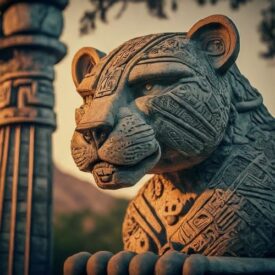American Mythology
American mythology isn’t a monolithic entity; it’s a vibrant mosaic formed by the contributions of Native American tribes, European colonists, and African slaves brought across the Atlantic. Delving into this realm, we encounter trickster spirits, courageous heroes, and awe-inspiring creation myths that paint a picture of a land brimming with wonder.
North American mythology, encompassing the stories of countless indigenous tribes, pulsates with deep respect for the natural world. Creation stories abound, with the Iroquois crediting Sky Woman for falling to earth and forming the continent, while the Navajo revere Changing Woman who birthed the Hero Twins. Trickster figures like Coyote among the Lakota and Raven on the Northwest Coast weave their mischief, shaping the landscape and teaching valuable lessons. Powerful spirits like the Great Hare of the Algonquin people and the thunder beings of various tribes command both respect and awe. These myths illuminate the intimate connection Native Americans felt with the land, its creatures, and the unseen forces that governed their lives.
Southern American mythology reflects the cultural gumbo that defines the region. African folktales brought by slaves intertwined with European fables and Native American beliefs, birthing unique tales. The trickster figure of Br’er Rabbit, popularized by the Uncle Remus stories, originated in West African folklore. The legend of La Llorona, the weeping woman searching for her drowned children, has roots in Aztec mythology. Voodoo, a complex spiritual practice with roots in West Africa, found fertile ground in the Southern United States, spawning its own set of myths and legends. These stories speak to the resilience of African Americans who, despite brutal circumstances, clung to their cultural heritage and reshaped it to reflect their new reality.
Mesoamerican mythology, though geographically distinct from the United States, holds a significant place in American mythology. The Maya, Aztecs, and Incas developed sophisticated belief systems with rich mythologies. The Maya creation story details the Popol Vuh, where hero twins defeat the lords of the underworld. The Aztecs believed their world had undergone several creations and destructions, with the current iteration overseen by the powerful sun god Huitzilopochtli. The Incas traced their lineage back to the sun god Inti, and their myths explored themes of creation, rulership, and the natural world. While these civilizations predate European contact, their influence on modern Mexico, Central America, and parts of the Southwestern United States ensures their myths remain a vital part of the American mythological landscape.
American mythology, in all its fascinating complexity, is a testament to the rich tapestry of cultures that have shaped the nation. From the reverence for nature in Native American tales to the resilience embodied in Southern myths, and the grandeur of Mesoamerican creation stories, every thread adds depth and intrigue to this ever-evolving narrative. Exploring these myths allows us to connect with the past, understand the present, and gain a deeper appreciation for the land we call home.
American Mythologies



